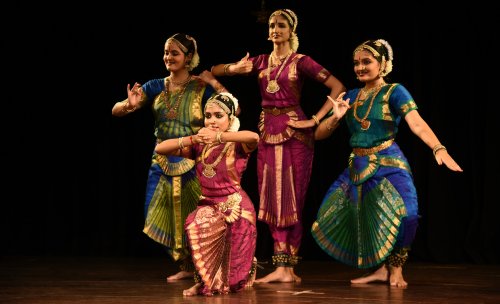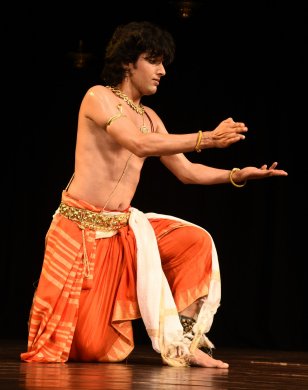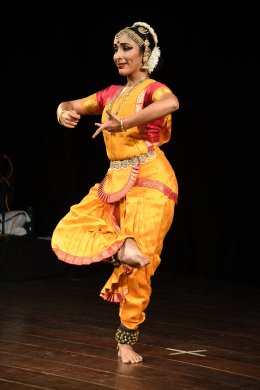
|   |

|   |
An exuberance of youthful spirit - Satish Suri e-mail: satishism@yahoo.co.in Photos: Chadda & Co July 25, 2018 The Youth in Dance program presented by Guru Padma Murali of Padmalaya Dance Foundation was a refreshing take both in terms of the concept and content of the presentation.The goal was to encourage and motivate young artists to come forward and showcase their research and allied work that many have taken up as original projects.  ‘Ishta Devatha’ by Padmalaya Ensemble Padmalaya Dance Foundation provided the first imprint of the program ‘Ishta Devatha’ which explores the composition of Adi Shankara’s ‘Shanmatham’ extolling the six paths of devotion to attain salvation. The dancers Sharadha Srinivasan, Poshini Zunjarwad, Ranjitha Kumar and Anindata Ashok began with a thodayam inspired invocation, followed by Arunagirinathar’s composition “Erum mayileri.” The choreography was fashioned to incorporate all the elements and expand a philosophy affirming through the power of verse, music and dance. Kaumaram - the worship of Subrahmanya, the commander in chief of the divine Muruga. Skanda - the supreme godhead of the Devas. Azhagar - for those who see his radiant beauty. Kartikeya – for the Krittikas. Guhan - the little boy, to his divine father Maheswara. Shanmugha – to Parvati who embraces him as six infants. Swaminatha –the preacher who bestows knowledge. Subrahmanya – the warrior. The dancers encapsulated several sancharis and the interconnected nritta provided a mosaic of movements with a vivid display of both rhythm and emotion to portray the rich tapestry of the divine Muruga.The elaboration of the sanchari showing the mighty Shiva overawed by the son who initiates him with the chanting of the Omkara Mantra was poignant and suffused with intensity. The legacy of the multifaceted genius Saint Tyagaraja in ‘Parampara’ was the theme of the next presentation. Two artists Naveen Hegde and Preethi Bharadwaj were chosen to explore the compositions associated with the parampara of Saint Tyagaraja. Naveen Hegde, a disciple of Nirupama and Rajendra, chose Patnam Subbramania Iyer’s kriti, “Raghuvamsa Sudha,” which glorifies the valour of Lord Ramachandra. His inspiration came from the study of the lyrics to portray Ramayana through the eyes of Hanuman. The artist's performance was characterised by zesty nritta with expressive mukha and hasta abhinaya. His vibrant footwork, the well-set sancharis, fine body kinetics and exploration of abhinaya to the sahitya were enriching.The delineation of the sanchari of Ahalya (shapavimochana) was impressive. A delicate skip of a gait in his movements provided a refreshing template to his artistry and lent charm to his dancing.  Naveen Hegde  Preethi Bharadwaj Preethi Bharadwaj provided the affidavit of her long years of training under Guru Bhanumathi. The dancer chose to reflect on the legacy of Tyagaraja as seen through vaggeyakaras Subbaraya Shastri and Poochi Srinivasa Iyengar. Her take on “Janani ninnu vina,” a kriti of Subbaraya Shastri, sought to explore the many aspects of the Mother of the world reflected in our biological mother. Nourishment is important in one’s life and she chose goddess Annapoorani to qualify her presentation. An arudi for the Pallavi describes the different stages of motherhood. Performed with languid grace, her portrayal of the subtle nuances added punch. The rhythmic coordination of the dancer provided the visual colour and warmth to the narrative. “Sarasamulaade,” a composition of Poochi Srinivasa Iyengar describes the discomfiture of the shy and reticent wife who comes up with all sorts of excuses to thwart the extrovert husband who wants to take her for a stroll into the open to display his affection. The detailed portrayal of the bhava showed strength and finesse qualified by the choreographic inputs of Bragha Bessell. Preethi Bharadwaj concluded with another composition of Poochi Srinivasa Iyengar, “Sadbhaktiyu galagajesi” in Kapi in which the composer expresses gratitude to “Santhana Rama” for installing Sadbhakti in him. The artist chose to perform it in Baithak style to understand the intensity that choreography can create in her mind. The soundscape with D.S.Srivatsa on the vocal, Aditya P.V. on the nattuvangam, Harsha Samaga on the mridangam and Karthik Sathavali on the flute added value and lustre to the presentation by Naveen Hegde and Preethi Bharadwaj.  Harinie Jeevitha & Bhairavi Venkatesan ‘Margam’ was the final presentation by the duo Harinie Jeevitha and Bhairavi Venkatesan of Sree Devi Nrithyalaya, run by Guru Sheela Unnikrishnan specialising in the Melattur style of Bharatanatyam. The alarippu in khanda chapu talam set the tone for a vibrant exposition by Harinie and Bhairavi. Sharada Kautvam on goddess Saraswati adapted from a Marathi song by Shelke describes the resplendent face of the goddess, the beautiful fingers with which she plays the veena, which abates the sorrows of all. Harinie and Bhairavi built on the theme playing with both the rhythmic and expressive elements of the composition by G.Srikanth with ebullience and zest. The varnam “Omkarakarini,” a composition of Balamuralikrishna set to tune in the lilting Lavangi ragam, hailing the mother goddess, was a moving spectacle sensational in its eloquence and charm. She is the embodiment of Omkara and she incarnates as Brahmani, enabling creation in the cosmos. She manifests as Vaishnavi to protect the universe and also appears as the fierce Rudrani doing the duty of destruction. She is the consort of Shiva who annihilated Tripura and she eternally dwells in the heart of Murali. A virutham, penned by B.M.Sundaram preceded the keertanam. The adavus chiselled to perfection, revealed the rigorous training and disciplined approach.The jathis were statements of lilting rhythm and strong control of balance. Complementing each other, Harinie and Bhairavi portrayed with perfect synchronisation and well-defined sancharis, delightful visual frames interspersing rhythmic intricacies that regaled the audience immensely. Following the varnam, Harinie and Bhairavi portrayed three select pieces. The keertanam, “Nrithyayathi Nrithyathi” composed by Maharaja Swathi Thirunal describes the dance of Shiva. The duo sculpted images of the immaculate Shiva who is accompanied by none other than Nandi on the damaru. A padam by Oothukadu Kavi,“Vishamakaara Kannan” was executed with joyous expression and aplomb. The next piece, a Dikshitar kriti “Ardhanareswaram” had different layers of expression portrayed with exciting intensity. The choreography created a mosaic of movements with the duo displaying a variety of aesthetic sculptural poses. They concluded with a thillana in ragam Bhoopalam, a composition of Muthuswamy Dikshitar set to tune by Dr.Balamuralikrishna.The charanam of this thillana hails lord Padmanabha who is decked with the Padmaraga gem on his chest. The collage of expressions, the vibrant footwork pulsating to the rhythm of the music, provided an ecstatic conclusion to the program. Bangalore based Satish Suri is an avid dance rasika besides being a life member of the Music and Arts Society. |